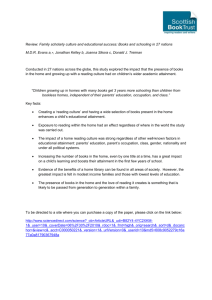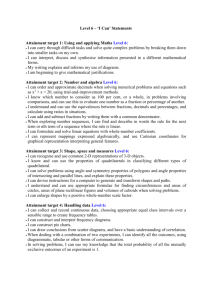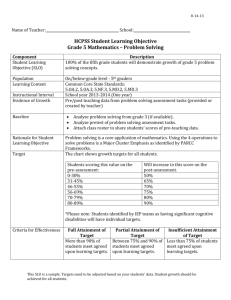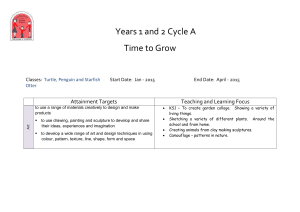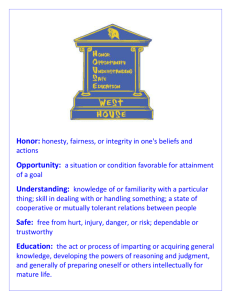Renewing the Promise: State Policies to Improve Higher
advertisement
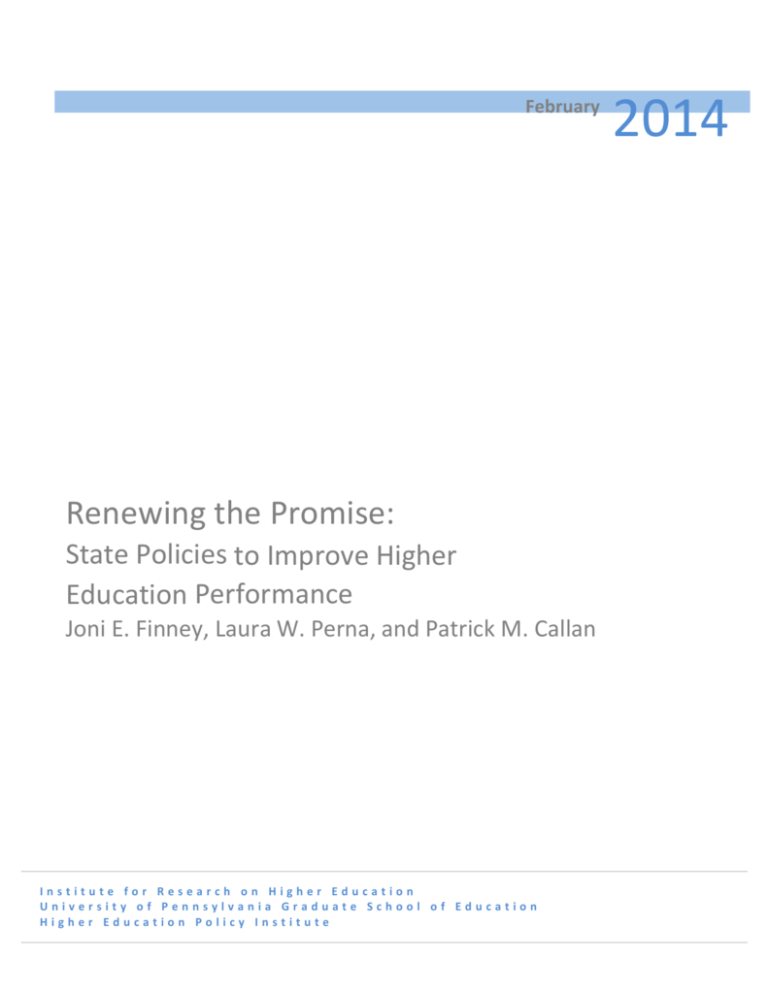
February Renewing the Promise: State Policies to Improve Higher Education Performance Joni E. Finney, Laura W. Perna, and Patrick M. Callan I n s t i t u t e f o r R e s e a r c h o n H i g h e r E d u c a t i o n U n i v e r s i t y o f P e n n s y l v a n i a G r a d u a t e S c h o o l o f E d u c a t i o n H i g h e r E d u c a t i o n P o l i c y I n s t i t u t e 2014 Renewing the Promise: State Policies to Improve Higher Education Performance Joni E. Finney, Laura W. Perna, and Patrick M. Callan Executive Summary As the need for a highly knowledgeable citizenry grows, fewer Americans are accessing training and education beyond high school. The failure to attain postsecondary degrees and workforce certificates is particularly pervasive among low-­‐income and minority populations. An undereducated citizenry leaves the country at a competitive disadvantage, diminishes the middle class, and lowers the standard of living for more and more people. Although the federal government plays an important role in higher education, states bear the primary responsibility for developing their own public higher education systems, including policies for funding and governing higher education and for connecting higher education with public schools. Renewing the Promise: State Policies to Improve Higher Education Performance summarizes the findings from a study that sought to understand how public policy explains the collective performance of higher education institutions in five states— Georgia, Illinois, Maryland, Texas, and Washington—that have similar challenges as other states, such as the need to increase educational attainment and close persistent gaps in opportunity by race, ethnicity, income, and geography. The study reviewed state higher education performance and policies from the early 1990s through approximately 2010, including policies and statutes related to higher education finance, accountability, structure, and governance. We augmented our review of state policies and data by interviewing political, business, and higher education leaders in each state. Findings and Recommendations We found that states struggle to develop policies in three general areas: using fiscal resources strategically; aligning educational opportunities to student needs; and easing student transitions between educational sectors. Based on these findings, we make the following policy recommendations: Make equity a top priority. The growing gaps in educational opportunity and attainment are one of the most serious issues facing higher education. No state 1 can successfully meet their higher education challenges without creating a level playing field for low-­‐income, minority, and first-­‐generation college students. Develop political consensus. States must develop political consensus for clear goals related to educational opportunity and attainment, as well as mechanisms to monitor and implement policies to achieve those goals. Work on all areas of performance simultaneously. Disconnected efforts, such as a singular focus on college completion, are far less effective, compared to working on all higher education performance areas at once, including college preparation and affordability. Create clear pathways to certificates and degrees. Greater state policy attention is required to ensure that high school students are prepared to academically succeed in postsecondary education, and to provide easy transfer for students from two-­‐year to four-­‐year institutions without losing credits. Match educational institutions and providers with regional education needs. Failure to provide the right mix of institutions or programs matched to student needs compromises goals for educational attainment. Focus on building incentives into state budget and linking finance policies. States must develop comprehensive higher education finance policies that offer incentives to institutions to increase institutional productivity, invest in student financial aid, and link tuition to the income of the population to be served. This report highlights the critical role higher education plays in the future well-­‐ being of the nation. In order to meet the needs of a strong workforce in the 21st century, more people need to enroll in and complete workforce certificates or college degrees. Helping more people get a postsecondary education is a national challenge that will be won or lost primarily at the state level. This report provides state leaders with the essential tools needed to boost educational opportunity and attainment. The public policies that states implement will be the ultimate test of a state’s commitment to improving educational attainment. 2 Introduction By any measure, the United States is not producing the educated citizens needed to build a 21st-­‐century workforce and a strong democratic society. Too many students—both young people and working-­‐age adults—lack the knowledge and skills required to succeed in education beyond high school. Too many people who could benefit from postsecondary education fail to enroll, or are shut out by limits placed on enrollment. The high and unpredictable cost to students and families discourages some students from enrolling and drives many others deep into debt. And no matter how we measure how states perform in higher education—by preparation, participation, completion, or affordability—we see large disparities by income, race and ethnicity, and geography. To increase educational capital and compete in the global economy, every state needs to improve its higher education performance. Additionally, no state can do so without creating a level playing field for low-­‐income, minority, and first-­‐generation college students. 1 Achieving this public agenda constitutes the major higher education challenge for states in the 21st century. To renew the promise of higher education, the nation needs to boost educational opportunity and attainment. Elected officials must ask whether the American Dream—opportunity for those who work hard and play by the rules—will be passed along to the next generation. Before we can answer yes, education and training opportunities beyond high school—increasingly the only path to economic mobility for most Americans—must become more widely available. This task is urgent not only for those who wish to personally benefit from education, but also for the prosperity of the nation as a whole. The State Review Project This project focuses on state policy not because federal higher education policy is unimportant, but because, in our federalist system, each state develops its own public higher education system, including policies for funding and governing higher education, connecting higher education with public schools, and achieving other shared state higher education goals. 1 According to the Center on Education and the Workforce at G eorgetown U niversity, in 2020 65% of all jobs will require some postsecondary education beyond high school; 24 million of these jobs will be newly created and 31 million of these jobs will become available as baby boomers retire. 1 Our multi-­‐year effort, the State Review Project, sought to understand how public policy explains the collective performance of higher education institutions in five states: Georgia, Illinois, Maryland, Texas, and Washington. 2 We examined state higher education performance and policies from the early 1990s through approximately 2010. Since the project began in the aftermath of the Great Recession, it gave us a chance to understand how state governments deal with higher education in difficult financial times, as well as how historical policies set the context for higher education performance. The performance and policies of the five states vary considerably. Although the five states we chose to study do not fully represent the experiences of all states, they vary in important ways that offer insights for all states. These variations include the performance and structure of their higher education systems, their levels of overall educational attainment, and other contextual characteristics, such as their demographic makeup and their economic and political culture. Of the five states we studied, all five rank in the top 20 in terms of overall size of the population: Texas ranks 2nd, Illinois 5th, Georgia 9th, Washington 13th, and Maryland 19th. Additionally all states but Illinois rank in the top ten in the projected growth of their 18-­‐ to 24-­‐year-­‐old populations. 3 Johns Hopkins University Press, 2014 These states also show significant diversity in the young population compared to the nation. In four of the five states the growth of Hispanic high school graduates is expected to exceed 80%, the national average, from 2008 to 2025: Georgia (272%), Illinois (47%), Maryland (245%), Texas (115%), and Washington (144%).4 Furthermore, the share of black high school graduates currently exceeds 15%, the national average, in three of the five case study states: 2 This project defined state higher education systems to include all postsecondary education providers: all public two-­‐ and four-­‐year institutions, private not-­‐for-­‐profit institutions, and private for-­‐profit institutions. 3 Sources: U.S. Census Bureau, “Table SFI: P5: Hispanic or Latino Origin by Race”; U.S. Census Bureau, “Table B1: The total population by selected age groups.” 4 Source: Western Interstate Commission for Higher Education, Knocking at the College Door: Projections of High School Graduates (2012). 2 Georgia (35%), Illinois (16%), Maryland (35%), Texas (13%), and Washington (4%).5 The five states also vary in terms of the effort necessary to meet standards of international competitiveness by 2020, as measured by the proportion of the population aged 25-­‐64 with at least an associate’s degree. In the top countries, 55% of the population has at least an associate’s degree; to reach that level the nation needs an annual increase of 7.9% by 2020. Our states vary on the annual increase to meet the target of international competitiveness: Georgia (10%), Illinois (5%), Maryland (5%), Texas (12%), and Washington (6%). 6 State Performance The years before 2000 saw relatively few attempts to compare states’ performance in higher education. The Measuring Up 7 series of state report cards, published from 2000 to 2008, called attention to how state higher education systems stacked up against the best-­‐performing states and, later, against international standards. These state reports focused attention on measures of performance rather than traditional measures of higher education inputs, such as the number of books in the library, the number of faculty members with PhDs, and the institutions’ reputations and resources. While Measuring Up informed states about their higher education performance, it didn’t identify what influenced differences in performance across states or changes over time in performance within a state. The State Review Project builds on the work of Measuring Up by showing how state policies can affect performance. To better understand state performance, we used data that could be compared across states, supplemented with state-­‐specific data, to understand four areas of higher education performance that, together, result in a state’s higher education attainment: 1) preparation for postsecondary education; 2) participation in workforce certificate or degree programs after high school; 3) completion of workforce certificates and degrees; and, 4) affordability. For each of the five case study states, we examined public policies that influenced higher education performance, including polices and statutes related to higher education finance, accountability, and structure and governance. We augmented our review of state policies by interviewing political, business, and higher education leaders in each state. 5 Source: Western Interstate Commission for Higher Education, Knocking at the College Door: Projections of High School Graduates (2012). 6 Sources: Kelly, P. “Projected Degree Gap: Percent of 25-­‐64 Year Olds with Associate Degrees or Higher”; National Center for Higher Education Management Systems, ACS Educational Attainment by Degree-­‐Level and Age Group (American Community Survey (2010). 7 Measuring Up is a biennial state-­‐by-­‐state report card published by the National Center for Public Policy and Higher Education from 2000-­‐2008. 3 The Relationship Between State Policy and Performance Below we offer brief snapshots of how state policy influences performance. These snapshots are not meant to be comprehensive; more detailed descriptions of how public policy influences state performance within the larger state context are available through the links below for each state and in our forthcoming book, The Attainment Agenda (Johns Hopkins University Press, 2014). Georgia: Perpetuating Disparities State Higher Education Performance Preparation How well is the state preparing its young people for postsecondary education? How well are students performing on college entrance exams or Advanced Placement tests? Participation To what extent are young and working-­‐age adults enrolled in workforce training and college degree programs? Do high school graduates enroll in college immediately after graduation? Completion To what extent do students persist from one year to the next in their educational programs? Are students completing workforce certificates or degree programs within the expected amount of time? Are students transferring from two-­‐year to four-­‐year institutions? Affordability What portion of family income is required to pay college costs for families of different income levels, after all financial aid is considered? To what extent are states contributing to financial aid programs? How much do students borrow to pay for postsecondary education? Below national average on most measures of higher education performance Poor performance in several areas of higher education for the state’s black, Hispanic, and low-­‐income populations Regressive higher education student financial aid policies; increase in academic requirements of state financial aid in response to shortfalls in lottery revenues that fund the program High production of workforce certificates by technical colleges but weak policies facilitating transfer between technical colleges and degree-­‐granting programs in the University System of Georgia Illinois: Story of Decline Top-­‐performing state in many measures of higher education performance (particularly affordability) in late 1990s; sharp declines through 2008 Large regional disparities in performance between Chicago and rest of Illinois, revealed along racial/ethnic lines Weakened state capacity to steer higher education following dismantling of historic state structure for higher education known as “system of systems” Political indifference toward higher education Unraveling of strategic finance policies, including cuts to one of the nation’s largest state need-­‐based financial aid programs 4 Maryland: Much Accomplished, Much at Stake Top-­‐performing state in most areas of higher education Considerably lower performance for black than white residents Lingering questions about compliance with Title VI of the 1964 Civil Rights Act Strong executive and legislative support for higher education and history of cooperation between state system leaders and political leaders Comprehensive plan for financing higher education in the future, promising greater stability of state resources, increased student financial aid, and tuition policies linked to family income Texas: Hard Choices Ahead Below national average in most areas of higher education performance, but evidence of improvement Broad political and business leader consensus on statewide goals for educational opportunity and attainment Regular public reports on progress toward educational goals Inequities in performance between large and growing Latino population vs. white population Differences in tuition across community college districts resulting in affordability problems and inequality of opportunity Declining affordability as a result of policies to increase institutional authority to establish tuition and a weak state financial aid program Unacknowledged policy tradeoffs between expanded research mission for seven institutions and need to focus on increasing undergraduate opportunities Washington: State Policy Leadership Vacuum Success in attracting well-­‐educated out-­‐of-­‐state residents but poor performance in baccalaureate degree production Political indifference toward higher education manifested in weak statewide steering capacity and failure to implement statewide strategic plans Higher tuition for students and families following increased institutional tuition-­‐setting authority Politically responsive community college system, but limited transfer opportunities for community college students even with state policies designed to expand upper-­‐division education opportunities 5 How State Policy Influences Performance These snapshots show some of the challenges that states face in aligning public policy to improve performance. States struggle to develop policies that 1) strategically use fiscal resources; 2) align or match educational opportunities in the state to student needs; and 3) ease student transitions between educational sectors. The figure below illustrates the relationship between state policy and state performance. STATE-SPECIFIC CONTEXT A Public Agenda for Higher Education Strategic Use of Fiscal Resources Student Pathways Through Education Assessment of Statewide Performance Align Educational Opportunities with Student Needs Overall Attainment & Equity in Attainment Source: Perna and Finney (2014) Efforts to use finance policy to increase educational opportunity and attainment must focus on 1) how states use incentives to fund institutions and improve productivity; 2) how states establish tuition policies; and 3) how states structure their financial aid policies. Except for Maryland, none of the five states we studied have a long-­‐term strategy to link state appropriations, tuition, and financial aid in ways that will help achieve higher levels of educational attainment. At the time of our study, the de facto finance policy in most states was “taking it one year at a time,” resulting in unstable funding for higher education and unpredictable tuition levels for students and families. Historically, these states, like most others, relied on funding formulas based on student enrollment and institutional mission. 6 Both Illinois and Washington were considered low-­‐ to moderate-­‐tuition states in the early 1990s and had robust, nationally recognized, need-­‐based financial aid programs; however, since then both states have reduced state financial aid programs and increased tuition at unprecedented rates. Neither state has built political consensus for planning efforts to improve institutional productivity. Looking at all five states, our findings about the strategic use of financial resources are as follows: State Appropriations for Higher Education In all five states, disproportionate cuts to higher education (relative to other state services) during economic downturns created instability in planning. State appropriations for higher education declined in all states, with few incentives to improve productivity. Tuition In three of the five states, the delegation of tuition-­‐setting authority to institutions not only led to large price increases but also drew attention away from larger higher education finance issues. In four of the five states, tuition policies made it more difficult for people with modest incomes to afford college. Financial Aid Inadequate need-­‐based financial aid in most states reduced the purchasing power of financial aid programs as higher education tuition increased. None of the five states protected need-­‐based student financial aid programs during the Great Recession as family income declined. Aligning Educational Opportunities with Educational Needs Few states have enough money to meet educational needs by building new campuses. But, states may use other mechanisms, including incentives for campuses to collaborate and more online learning. Maryland created regional educational centers that house a range of academic programs from participating institutions, although enrollment in these centers is not at the optimal level. In the 1990s, Washington expanded two research universities (the University of Washington and Washington State University) through branch campuses with the goal of increasing the state’s higher education capacity. But this expensive strategy failed to meet enrollment targets, because these institutions were built in regions that are not convenient for students who need to be served. More recently, Washington authorized the online Western Governors University to provide upper-­‐division education for students transferring from community colleges. Other states have let community colleges offer bachelor’s degrees in certain fields. Although this latter strategy creates more baccalaureate degree opportunities for students, it runs the risk of distorting the community colleges’ mission and ultimately increasing costs to students and families since it is more expensive to operate four-­‐year colleges and universities. 7 All five states are struggling to meet educational needs within their own borders. For example, Texas identified five regions in the state with very different challenges. Some of these regions underperform in college preparation or access, others in college completion. Meeting educational needs often requires policy tradeoffs that states fail to recognize. For example, the highly regarded “Closing the Gaps” plan in Texas to increase educational opportunity and achievement is likely to be at odds with the goal of expanding the research mission to an additional seven public universities, thanks to the high price of creating nationally or globally competitive research institutions. In fact, Texas recently took public endowment revenue that had supported comprehensive four-­‐year institutions and redirected it toward the expansion of research at the seven emerging research universities. Some of the findings related to matching educational opportunities with state needs include: State leaders often fail to acknowledge the policy tradeoffs between increasing educational opportunity and attainment, on the one hand, and state goals to expand research, on the other. Policies to expand the mission of community colleges by letting them award baccalaureate degrees risk increasing costs for the state and for students and families due to the higher cost of four-­‐year programs. Alternative forms of delivery, such as Western Governors University, can potentially increase access in underserved areas. Providing a range of academic programs through existing higher education institutions and within realistic budget constraints is a challenge for all five states. Student Pathways to Degrees States need smooth pathways between educational sectors—particularly between high school and postsecondary education and between two-­‐year and four-­‐year institutions—to produce high levels of educational attainment. Every state in our study had organized a state commission or working group to improve students’ pathways from high school to postsecondary education. Although these groups raise awareness and encourage dialogue across state education sectors, they have had little success enacting policies to improve performance. In Texas, a legislative initiative is making progress in clarifying college-­‐level expectations by developing end-­‐of-­‐course exams in the 11th grade so that students know whether they are college ready. If students pass the exam, they can enroll directly in college-­‐credit-­‐bearing courses. If they do not pass, they can take additional college preparation courses during the 12th grade. In contrast to this policy leadership, other states have postponed taking action on the pathway from high school to college until the Common Core Standards and their accompanying assessments are ready to be implemented. 8 Easing the transfer of students from two-­‐year to four-­‐year institutions will also improve college opportunity and attainment. Many states, including the five we examined, enroll a large proportion of students in community colleges. Maryland and Texas strengthened transfer policies by developing associate degrees in specific fields of study (such as teacher education and engineering) that are approved by the four-­‐year institutions. These associate degrees earned at community colleges transfer in full without the loss of academic credits. Our findings related to improving pathways through education include: Statewide K-­‐16 (or P-­‐16) task forces and commissions on student transitions rarely lead to state policies to improve performance. State policies to identify and assess college-­‐ready knowledge and skills, developed collaboratively between higher education and K-­‐12 schools, hold promise for increasing educational attainment. Guaranteeing a transfer curriculum or degree that is accepted with no loss of credit hours by four-­‐year institutions is a promising state policy to improve opportunity and achievement. A Public Agenda to Improve Educational Opportunity and Attainment State leaders face critical questions: To what extent is the state willing to play a role in the future stewardship of higher education? Will states shoulder this responsibility, as they have done historically, or will they—by policy or by default— delegate this responsibility exclusively to higher education institutions? Our view is that a long-­‐term policy for a public agenda tied to the well-­‐being of individuals, state economies, and state civic cultures is fundamentally a state responsibility. This responsibility must also be shared with business and higher education leaders. States may have promising programs and initiatives to improve degree attainment but still lack political support for future stewardship. Historically strong relationships between state leaders and higher education leaders, such as in Illinois and Washington, have unraveled due to political indifference and economic crises. In Georgia, state leaders, as well as some institutional leaders, have failed to come to grips with the reality that its future success is linked to opportunities for African Americans and Latinos. Texas, while making progress in establishing political consensus for state goals, must understand the limitations in public finance and address the need to improve educational attainment. Of the five states we examined, Maryland has come the closest to developing a public agenda for higher education, as reflected in its comprehensive finance plan. What becomes clear from this study is that the aspirations of individual institutions alone are insufficient to create a public agenda that dramatically improves educational attainment. States need policies to steer higher education toward this end. 9 Recommendations for State Policymakers Develop political consensus for clear goals related to educational attainment, as well as mechanisms to monitor and publicly report on those goals States must provide leadership in establishing goals for increased certificate and degree attainment. Establishing goals and the necessary policy structure to accomplish them is fundamentally a political responsibility, to be addressed through the political process. Higher education and the public must also support these goals and understand their relationship to individual and civic benefit. Work on all areas of performance simultaneously Many states set goals for college completion but fail to promote student preparation or preserve access and affordability. Improving completion rates alone will not significantly increase overall educational attainment. More students than the ones who are currently enrolled must earn workforce certificates and degrees. Enrolling more students, especially those from historically underserved groups, and ensuring that they complete workforce certificate and degree programs, is a necessary condition for achieving increased educational attainment. Each state faces a different challenge. Some of the most populous states are facing historic increases in population, and in some states minority residents are now the majority population. In contrast, other states face population declines, making it important to encourage high school graduates, or those with some college but no degree, to continue their education. In many cases, these students are of modest economic means. Focus on powerful incentives built into the state budget and link all finance policies State leaders often fail to use incentives built into the budget to encourage institutional behavior that advances the public agenda. If states fail to invest in need-­‐based financial aid, the gap between low-­‐income and higher-­‐income students’ participation rates should not be expected to close. Likewise, if states fail to rein in tuition increases, the purchasing power of financial aid will fall, and students and families will continue to bear an increasing share of the costs. Furthermore, if states fail to provide incentives for increased institutional productivity through their funding policies, they can expect little improvement in educational attainment. Create clear pathways to certificates and degrees Many states are not doing enough to help students move to the next level of education. Greater state policy attention is required to ensure that high school students are prepared to academically succeed in postsecondary education and to provide easy transfer for students from two-­‐year to four-­‐year institutions without losing credits. 10 Match educational institutions and providers with regional education needs Failure to provide the right mix of institutions or programs matched to student needs will compromise goals for educational attainment. Cost-­‐effective ways to address educationally underserved regions in the state using existing institutions, collaborations among institutions, or through online learning is a challenge for all five states. Make equity a top priority The insidious and growing gaps in educational opportunity and attainment between those with financial means and those without is one of the most serious issues facing higher education. These growing income gaps often overlap with communities of color. Gaps in educational attainment are also evident by state and by regions within a state. Explicit state policies to provide a level playing field are necessary to increase educational attainment. Conclusion Helping more people get a postsecondary education is a national challenge that will be won or lost primarily at the state level. Implementing public policies that achieve these ends will be the ultimate test of a state’s commitment to improving educational attainment. Some states, no matter how they are performing now, are showing hopeful signs of progress, although there is no guarantee that they will succeed in renewing the promise of higher education for the 21st century. Other states are falling behind, or continue to face their problems with no policy direction or strategy. Ultimately, state leaders must determine whether higher education continues to provide the public benefits that justify this important and ambitious public agenda. 11 About the Authors Joni E. Finney Joni E. Finney is director of the Institute for Research and Higher Education (IRHE) and Practice Professor at the Graduate School of Education at the University of Pennsylvania. She is also an affiliate with the Wharton Public Policy Initiative at Penn. For over 20 years, she has worked with state leaders to improve the public policies that govern higher education. Finney directed and developed the nation’s first state-­‐by-­‐state report card on higher education, Measuring Up. In addition to The Attainment Agenda (with Laura Perna, 2014), Finney has co-­‐authored Public and Private Finance of Higher Education: Shaping Public Policy for the Future (1997, ACE/Oryx Press); Designing State Higher Education Systems for a New Century (1999, ACT/Oryx Press) and Financing American Higher Education in an Era of Globalization (2012, Harvard Education Press). Laura W. Perna Laura W. Perna is executive director of the Alliance for Higher Education and Democracy (AHEAD), professor in the Graduate School of Education, Faculty Fellow in the Institute for Urban Research, and Penn Fellow at the University of Pennsylvania. She is former Vice President of the Postsecondary Education Division (Division J) of the American Education Research Association (AERA) and President-­‐ elect of the Association for the Study of Higher Education (ASHE). In addition to The Attainment Agenda: State Policy Leadership for Higher Education (with Joni Finney, 2014) other recent books include Preparing Today’s Students for Tomorrow’s Jobs in Metropolitan America: The Policy, Practice, and Research Issues (2012, University of Pennsylvania Press) and The State of College Access and Completion: Improving College Success for Students from Underrepresented Groups (with Anthony Jones, 2013, Routledge). Patrick M. Callan Patrick M. Callan is president of the Higher Education Policy Institute. He previously served as president of the National Center for Public Policy and Higher Education, executive director of the California Higher Education Policy Center, the California Postsecondary Education Commission, the Washington State Council for Postsecondary Education, the Montana Commission on Postsecondary Education, and as vice president of the Education Commission of the States. Callan is the author of many articles and papers on education, educational opportunity, public accountability, financing of higher education, and leadership. Callan is co-­‐editor of Public and Private Financing of Higher Education: Shaping Public Policy for the Future (1997) and The Learning Connection: New Partnerships between Schools and Colleges (2001), and co-­‐author of Designing State Higher Education Systems for a New Century (2001) and Financing American Higher Education in the Age of Globalization (2012). 12 About the Project The State Review Project was guided by a national advisory committee including Julie Davis Bell, National Conference of State Legislatures; Patrick Kelly, National Center for Higher Education Management Systems; Paul Lingenfelter, State Higher Education Executive Officers; Richard R. Richardson, New York University; and Jane Wellman, Delta Cost Project. Graduate students from the University of Pennsylvania participating in data collection and analysis include Michael Armijo, Awilda Rodriguez, and Jamey Rorison. The State Review Project was supported with funds from the National Center for Public Policy and Higher Education through grants from the Bill and Melinda Gates Foundation and the Lumina Foundation for Education. Students participating in the project were supported, in part, by the Institute of Education Sciences, U.S. Department of Education, through Grant #R305B090015 to the University of Pennsylvania. 13

